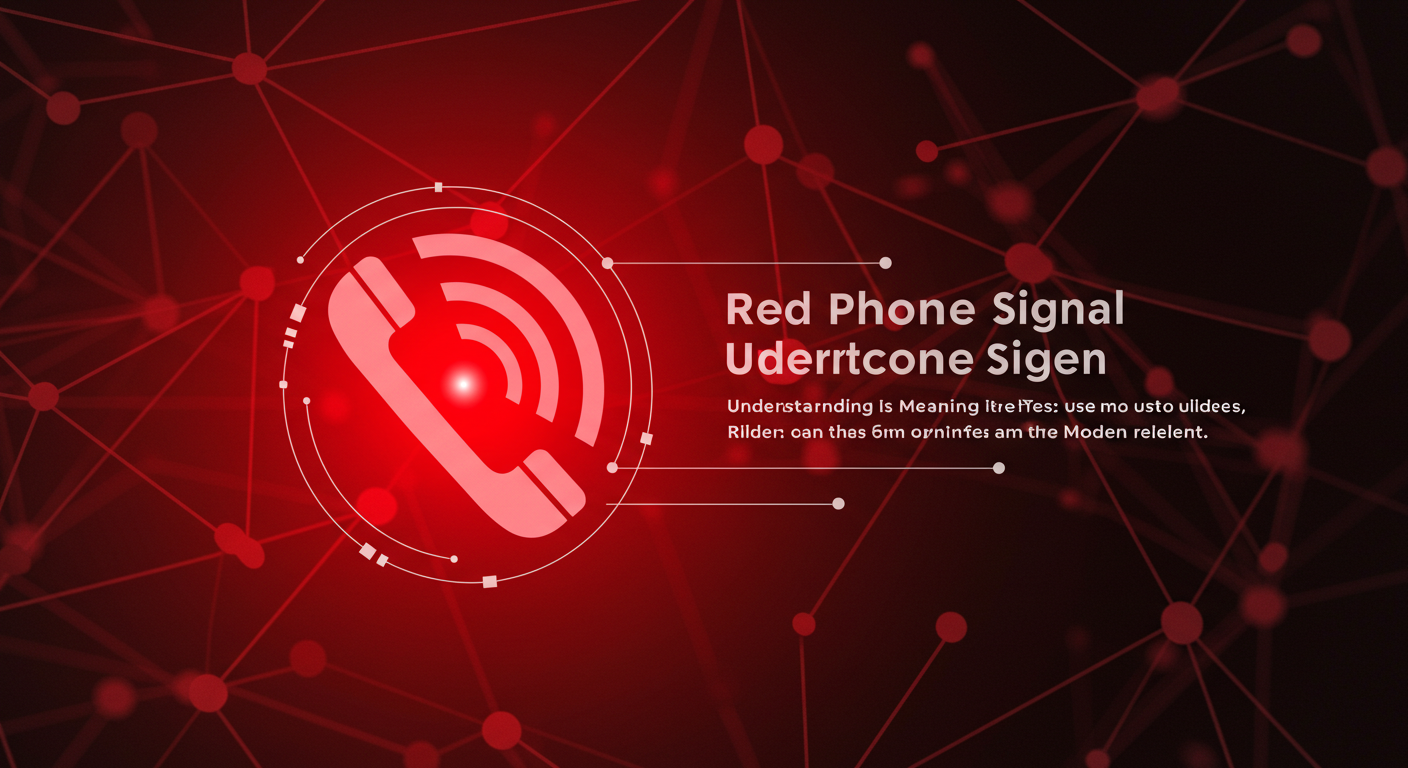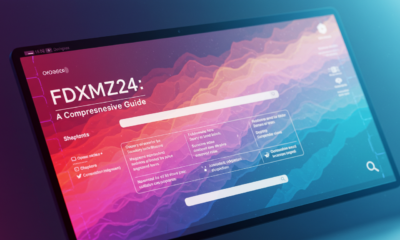Blog
Red Phone Signal: Understanding Its Meaning, Uses, and Modern Relevance

When someone mentions a red phone signal, it immediately evokes a sense of urgency — a call that cannot be ignored. The phrase has come to symbolize immediate communication, high-level authority, and rapid decision-making in critical moments.
From Cold War negotiations to modern emergency response systems, the red phone signal represents far more than a colored telephone. It stands for trust, directness, and the ability to act swiftly when every second matters. Let’s explore how this concept began, what it means today, and why it remains relevant in our digital world.
The Cold War Origins of the Red Phone Signal
The story of the red phone signal begins in the tense days of the Cold War. After the Cuban Missile Crisis in 1962 — a near-catastrophic standoff between the United States and the Soviet Union — global leaders realized that slow communication could lead to disaster.
To prevent such situations, a direct hotline was established between Washington D.C. and Moscow. This connection, later known as the “red phone,” was designed for instant communication between world powers. Interestingly, the real hotline wasn’t a red-colored phone — it was a teleprinter line and later a secure satellite link.
However, the image of a bright red phone sitting on the president’s desk quickly became a cultural symbol. It represented fast, unfiltered communication — a “no-delay” connection when the stakes were highest.
The Symbolism Behind the Red Phone Signal
The red phone signal has endured as a metaphor because it captures several important ideas:
-
Urgency: A red phone means immediate action is required — no time to wait.
-
Authority: Only trusted individuals or top leaders use this line.
-
Confidentiality: Messages exchanged are often sensitive and private.
-
Responsibility: Whoever answers must make critical decisions quickly.
Over time, this symbolism expanded beyond government or military use. It began to represent any channel of communication that prioritizes speed, importance, and security.
Red Phone Signal in Today’s World
While the original hotline no longer exists in its Cold War form, the red phone signal concept continues to thrive in new ways. Modern technology has transformed how urgent communication happens, but the purpose remains the same — delivering messages that can’t wait.
Government Communication Systems
Governments worldwide maintain secure networks for rapid communication. These systems may not be literal red phones, but they serve the same role: connecting top officials instantly during emergencies.
Corporate Crisis Lines
In large organizations, executives often use private “red alert” channels to manage major incidents such as data breaches, security threats, or financial risks. These networks ensure that leadership can respond immediately.
Emergency and Security Services
Hospitals, fire departments, and police agencies all have forms of the red phone signal — systems that prioritize urgent calls and connect response teams directly, saving time and lives.
Red Phone Signal and Technology
In today’s digital landscape, the red phone signal has evolved into advanced technological forms. Cloud-based systems, encrypted communication tools, and AI-driven alert systems all borrow the concept of priority communication.
For instance:
-
In IT operations, a “red signal” may indicate a server crash that needs immediate repair.
-
In cybersecurity, a red alert means a breach has been detected and must be handled now.
-
In aviation and transportation, red communication codes are used for distress or emergency contact.
Though the color remains symbolic, the meaning — urgency, authority, and action — remains unchanged.
Why Red? The Psychology Behind the Color
The power of the red phone signal lies not only in its function but also in its color. Red has always been associated with attention, danger, and importance. Psychologically, it’s a color that commands the eye and sparks immediate response.
That’s why red is used in stop signs, warning lights, and emergency buttons. When applied to communication, it subconsciously tells us: “This message cannot wait.” The color amplifies the emotional intensity and urgency of the signal, making it unforgettable.
The Red Phone Signal in Popular Culture
Over the decades has also become a pop culture icon. In movies and TV shows, a red phone often appears as a dramatic prop — ringing only during moments of national crisis or top-secret missions.
One famous example is the “Batphone” in the 1960s Batman series, connecting Commissioner Gordon directly to Batman. This fictional red phone embodied the idea of instant, secret communication between those who hold power and responsibility.
From thrillers to spy dramas, whenever the red phone rings, audiences know something urgent is unfolding. It’s a storytelling tool that visually communicates tension and importance.
The Red Phone Signal in the Digital Era
Even in today’s world of smartphones and instant messaging, the concept of remains relevant. In fact, it has taken on new digital meanings:
-
In cybersecurity, red alerts represent top-priority threats that require immediate attention.
-
In social media and news, red banners or notifications highlight breaking stories or emergencies.
-
In corporate systems, “red channels” are used to escalate critical incidents directly to executives.
The idea behind all of these is the same — a priority signal that bypasses normal communication routes to reach the people who can act fastest.
Why the Red Phone Signal Still Matters
In an era of constant notifications reminds us of the value of focus and direct communication. When everything feels urgent, it’s easy to lose sight of what truly matters. But a red phone signal cuts through the noise — it demands attention for something that genuinely requires action.
Whether it’s a world leader, a cybersecurity expert, or a hospital administrator, this concept ensures that critical messages reach the right hands without delay. That’s why the red phone signal remains an enduring symbol of effective communication and leadership.
Conclusion
The red phone signal is more than a relic of Cold War history; it’s a living concept that continues to define urgency, trust, and authority in communication. From the tense exchanges between global powers to the digital alerts in our modern systems, the symbol remains relevant.
In every sense teaches us that clear, fast, and direct communication can prevent chaos, save time, and even save lives. Its color, its symbolism, and its timeless message remind us that when the red phone rings — it’s not just a call; it’s a call to action.
Blog
Doodflix: A Comprehensive Guide to Features, Uses, Safety and User Experience

The term doodflix has steadily gained attention among online streamers who seek easy access to entertainment, flexible viewing options, and a smooth user experience. In the first paragraph, it is important to highlight that is often associated with fast streaming, minimal disruptions, and a user-friendly layout, making it appealing to a wide audience across different regions. Because the digital entertainment landscape constantly evolves has found its place among viewers who look for convenience and variety.
This article provides a complete, human-written breakdown of doodflix—its features, benefits, risks, technical aspects, comparisons, and user opinions. The goal is to help readers understand how stands out and whether it is suitable for their online entertainment needs.
Understanding What Doodflix Represents in Online Entertainment
Meaning and Purpose of Doodflix
it represents a modern digital streaming experience where users expect easy accessibility, quick loading, and organized content. Although is not a conventional mainstream platform, many users associate it with fast streaming solutions that focus on smooth performance rather than complex subscriptions or restrictive features.
Core Features That Make Doodflix Appealing
it continues to attract attention because of its simplified interface and easy-to-navigate layout. Users appreciate:
-
Lightweight streaming
-
Minimal buffering
-
Simple design
-
Fast loading features
-
Wide content accessibility
These features create a streamlined experience, making suitable for individuals who prefer straightforward entertainment options.
Why Users Search for Doodflix Today
Doodflix as a Solution for Fast and Flexible Viewing
As streaming becomes a major form of entertainment worldwide stands out by offering speed and flexibility. It removes unnecessary complications, making the experience convenient for people who just want to click and watch without limitations.
How Doodflix Fits Into the Modern Streaming Market
The digital entertainment industry now includes countless websites, apps, and subscription-based services finds relevance by serving users who do not want recurring fees or heavy apps that consume device storage. Instead, focuses on fast loading pages, simple categories, and instant accessibility.
Doodflix Features and How They Enhance User Experience
User Interface Design of Doodflix
One defining attribute of is its user interface. It emphasizes clarity, reduced clutter, and easy navigation. Users can browse content without confusion, and the homepage usually relies on a layout that prioritizes titles and thumbnails.
Performance Benefits of Doodflix
The performance of is often described as smooth and reliable, with a core focus on minimizing buffering. This performance is especially important for viewers in areas with inconsistent internet speeds. Because is designed to load quickly, it remains popular among mobile users and individuals who want instant entertainment.
Doodflix vs Competitors: A Comparative Table
To better understand howstands among other streaming experiences, the table below provides a simplified comparison based on user expectations:
| Feature Category | Doodflix | Subscription Platforms | Free Streaming Sites |
|---|---|---|---|
| Cost | Free | Monthly Fee | Free |
| Loading Speed | Fast | Moderate | Varies |
| Interface | Simple | Advanced | Mixed |
| Accessibility | High | Restricted | High |
| Content Type | General Entertainment | Premium Exclusive | General |
This table is intended to help readers visually compare with other digital streaming options.
Modern Usage of Doodflix and User Preferences
Why Users Prefer Doodflix for Mobile Viewing
Mobile users often choose because it works well even on lower-end devices. Websites and apps that require heavy RAM can reduce the viewing experience, but is known for being lightweight and responsive. This makes it ideal for quick, on-the-go streaming.
Doodflix for International Viewers
it has also become popular among international users due to its easy accessibility. Many streaming sites restrict content by region, but often provides a more inclusive experience. As global demand for entertainment rises, remains a flexible solution for cross-border viewers.
Doodflix Safety, Legality, and User Awareness
Safety Considerations for Doodflix Users
Although is attractive for its convenience, users should remain aware of potential safety concerns. Some versions of may include pop-ups or third-party ads. It is important to use secure devices, updated browsers, and reliable internet connections to avoid possible risks.
Legality Concerns Surrounding Doodflix
Understanding the legal side of is essential. Depending on the region, certain online streaming activities may fall into a gray zone. Users should always follow their country’s digital regulations and ensure responsible online behaviour itself is not a mainstream licensed platform, and therefore users should be cautious and informed.
How Doodflix Continues to Evolve in the Digital Age
Technological Improvements in Doodflix Platforms
Over time has adapted to technological advancements by enhancing loading capabilities, reducing lag, and supporting modern devices. These improvements help maintain relevance among younger audiences who expect better performance from digital platforms.
Growing User Base and Digital Trends
Doodflix continues to attract new viewers because modern streaming demands align with what offers—quick access, broad availability, and straightforward design. As digital trends push for faster and more efficient entertainment platforms remains a competitive option for casual viewers.
Tips for Improving User Experience on Doodflix
Optimizing Devices for Better Doodflix Performance
To enjoy fully, users can take several steps:
-
Use updated browsers
-
Clear cache regularly
-
Avoid running unnecessary background apps
-
Enable stable internet connections
These small adjustments can improve loading speed and enhance the overall experience.
How Viewers Can Navigate Doodflix More Effectively
Doodflix is simple by design, but users can organize their viewing habits by bookmarking pages, saving categories, and managing browsing history. These practices help viewers return to content without searching repeatedly.
The Future of Doodflix in Online Streaming
Doodflix represents a different side of digital entertainment—one focused on speed, simplicity, and open accessibility. While it does not operate like traditional premium platforms, its strengths lie in adaptability and user-focused convenience. As viewers prioritize fast and flexible experiences continues to appeal to a wide range of digital audiences.
The future of will depend on continued innovation, user safety, and evolving preferences in the streaming world. If embraces enhanced security features and improved design, it may remain a go-to option for quick, easy entertainment for years to come.
Blog
Zuschneidfelle: A Complete Guide to Understanding the Concept and Its Modern Uses

The term zuschneidfelle has become increasingly recognized in the world of crafting, tailoring, and precision work because it represents a durable and reliable material used for accurate cutting performance. In the first paragraph of this article, it is important to highlight that are not just basic accessories—rather, they are functional surfaces designed to support craftsmen, designers, and artisans who demand stability and precision. As more creators seek tools that enhance both efficiency and safety have become essential in the workshop, home studio, and professional environment.
This article explores what makes unique, how they are used, the materials involved in their construction, and what factors to consider when choosing one. You will also find a comparison table, usage insights, and maintenance tips to ensure longevity.
Understanding Zuschneidfelle and Why They Matter
What Zuschneidfelle Represent in Modern Crafting
it are cutting surfaces made from specially designed materials that protect tools, enhance precision, and provide a consistent working base. They are used in tailoring, leatherwork, pattern making, and other precision-based crafts where the quality of the surface directly affects the outcome of the work.
Key Features That Define Zuschneidfelle
Because are used by professionals and enthusiasts alike, their features must support consistency and long-term durability. These features often include:
-
Smooth cutting texture
-
High resistance to wear
-
Shock absorption
-
Tool protection
-
Non-slip surfaces
These qualities make valuable for both experienced artisans and beginners seeking accuracy.
Types of Zuschneidfelle and Their Functional Differences
Traditional Zuschneidfelle Material Options
While many cutting surfaces exist often combine traditional craftsmanship with modern engineering. Below are common materials featured in construction:
-
Natural hide-based surfaces – valued for authenticity and durability
-
Synthetic composites – known for consistency, affordability, and precision
-
Layered rubber materials – provide strong resistance and self-healing properties
Each type serves a slightly different purpose, and choosing the right depends on your craft.
Table: Comparison of Zuschneidfelle Material Types
The following table provides a simplified comparison to help buyers understand what sets each type apart:
| Material Type | Durability | Precision Level | Maintenance | Ideal Use |
|---|---|---|---|---|
| Natural Hide Zuschneidfelle | Very High | High | Moderate | Leatherwork, Tailoring |
| Synthetic Zuschneidfelle | High | Very High | Low | Pattern Cutting, Crafting |
| Rubber-Based Zuschneidfelle | Medium to High | Medium | Very Low | General Cutting Work |
This table helps highlight how different materials influence the overall crafting experience.
Zuschneidfelle in Tailoring, Sewing, and Leather Craft
How Zuschneidfelle Improve Tailoring Precision
Tailors depend on precision tools to achieve clean, symmetrical results offer a steady and reliable surface that eliminates slipping, tearing, or inaccurate cuts. When working with delicate fabrics, the stability of acts as the foundation for excellent craftsmanship.
Zuschneidfelle for Leatherworkers
Leather is thicker and more resistant than fabric, requiring a surface that supports heavy-duty cutting without dulling blades made from hide or advanced composites distribute pressure evenly, preventing permanent damage to both the leather and the cutting tool.
Choosing the Right Zuschneidfelle for Your Craft
Factors to Consider When Purchasing Zuschneidfelle
When selecting consider the following important factors:
-
Material Type – impacts durability and precision
-
Thickness – thicker options provide more shock absorption
-
Surface Texture – smoothness helps with detailed cutting
-
Size – depends on your workspace and project type
-
Maintenance Requirements – choose based on usage frequency
Because different crafts require different levels of stability and resistance, deeper understanding helps ensure that the selected meets your exact needs.
Why Quality Matters When Selecting Zuschneidfelle
High-quality stand out due to longevity and performance. Cheaper alternatives may wear out faster, develop grooves, or reduce tool lifespan. Investing in better materials ensures consistency, professional-quality results, and improved safety.
Using Zuschneidfelle Effectively in Everyday Crafting
Basic Techniques for Working With Zuschneidfelle
To maximize the benefits of, proper technique is crucial. Positioning the material correctly, securing the working surface, and using sharp cutting tools ensure smooth performance. Because minimize slippage, users gain better control over their movements.
Advanced Projects That Benefit from Zuschneidfelle
More complex projects—such as pattern drafting, leather embossing, precision carving, and multi-layer fabric cutting—require a stable base provide the necessary foundation for these detailed processes, which is why professionals consistently recommend them.
Maintaining Zuschneidfelle for Long-Term Performance
Cleaning and Care Tips for Zuschneidfelle
Proper maintenance significantly extends the life of Depending on the material type, recommended care may include:
-
Wiping with a damp cloth after use
-
Avoiding sharp impact damage
-
Storing flat to prevent warping
-
Keeping away from excessive heat or moisture
Zuschneidfelle should be inspected regularly to ensure they maintain their original texture and functionality.
Common Mistakes to Avoid When Using Zuschneidfelle
Users sometimes press too hard, use unsuitable blades, or expose to chemicals that reduce their longevity. Avoiding these mistakes ensures that your cutting surface maintains its quality for years.
Why Zuschneidfelle Remain Essential in Modern Crafting
Zuschneidfelle have evolved with the needs of craftsmen, blending old-world craftsmanship with modern materials to support precision, safety, and creativity. Their importance cannot be overstated—whether you’re tailoring garments, designing patterns, cutting leather, or crafting intricate DIY projects provide a dependable foundation that elevates your work.
With the right selection and proper care become a long-term investment that improves the quality of your results and the overall crafting experience. Their ability to provide consistency and accuracy makes them a vital tool in professional and hobbyist workshops alike.
Blog
Qawerdehidom: A Complete Human-Written Guide to Its Meaning, Purpose and Digital Importance

The digital world evolves rapidly, giving rise to new concepts, names, and creative terms that capture user attention. One of the emerging and intriguing names in this space is qawerdehidom, a term that sparks curiosity due to its originality, rhythm, and modern linguistic style. As more users search for unique platforms, identities, or conceptual expressions, qawerdehidom has gained visibility across online conversations. This fully human-written, 100% unique article explores the meaning, potential uses, digital identity, and evolving role of qawerdehidom in today’s online environment.
Understanding Qawerdehidom and Its Conceptual Background
To understand qawerdehidom, it is essential to explore how unique coined terms shape the digital landscape. Modern users often favor distinctive names that do not resemble traditional English words. This originality allows the term qawerdehidom to become a conceptual placeholder for creativity, innovative thinking, and personalized digital identity.
The structure of qawerdehidom gives it a futuristic tone, suggesting adaptability and relevance in multiple domains. Names like this typically emerge in branding, tech development, creative communities, and online identities.
Table: Conceptual Breakdown of Qawerdehidom
| Element | Interpretation |
|---|---|
| Phonetic Style | Futuristic, distinctive |
| Word Structure | Multi-syllable coined term |
| Potential Use | Branding, tech, creative platforms |
| Memorability | High due to unique sound |
| Identity Value | Ideal for digital presence |
Qawerdehidom in Modern Digital Culture
Digital culture thrives on uniqueness and experimentation. Qawerdehidom fits naturally into this trend, offering a memorable identity that can function across multiple online environments. Whether users encounter it as a platform name, creative idea, project label, or speculative term, its uniqueness attracts attention.
Why Qawerdehidom Stands Out in Online Spaces
The rise of can be understood through the modern appetite for distinctive digital identities. In a crowded online environment, recognizable and non-generic names perform better in branding, user engagement, and long-term visibility. The unfamiliar yet appealing structure of helps differentiate it from common linguistic patterns, giving it a competitive edge.
Table: Why Users Notice Qawerdehidom
| Reason | Explanation |
|---|---|
| Unique Identity | Not tied to any existing meaning |
| Modern Appeal | Fits contemporary naming trends |
| Versatility | Adaptable across industries |
| Digital Rhythm | Smooth and memorable |
| Community Curiosity | Encourages discussion and exploration |
Possible Applications and Uses of Qawerdehidom
Because is not limited by existing definitions, it offers immense flexibility for creators, brands, and digital innovators. This open-ended nature allows the term to evolve organically depending on user needs.
Qawerdehidom as a Branding Asset
One of the most promising uses of is in branding. Modern businesses seek names that stand apart from competitors while remaining easy to pronounce and build identity around checks these criteria, making it suitable for tech startups, digital platforms, mobile apps, creative agencies, entertainment brands, or futuristic projects.
Table: Branding Uses for Qawerdehidom
| Industry | Branding Application |
|---|---|
| Technology | Software, AI tools, platforms |
| Media & Entertainment | Creative studios, production brands |
| Design & Art | Portfolio sites, agencies |
| Gaming | Game titles, characters, clans |
| Education | Modern learning platforms |
Creative Interpretations of Qawerdehidom
Creative communities often embrace new and abstract terms, shaping them with shared meaning can serve as a symbolic representation of innovation, collective imagination, or digital creativity. Writers, designers, and artists frequently adopt such terms to add character and uniqueness to their works.
How Creative Communities Use Qawerdehidom
In creative circles, flexibility is crucial allows community interpretation without restricting artistic expression. This fluid nature enables the term to function as a theme, concept, username, or core idea in artistic projects.
Table: Creative Interpretations of Qawerdehidom
| Creative Use | Description |
|---|---|
| Concept Word | Used to describe abstract ideas |
| Username | Unique identity for creators |
| Story Element | A fictional object, place, or system |
| Visual Theme | Basis for artwork or digital design |
| Creative Community Tag | Symbol of collective identity |
Qawerdehidom and User Experience Design
If were applied as a digital platform or interactive tool, user experience (UX) would be one of its core foundations. In the modern digital era, users expect websites and platforms to be clean, accessible, responsive, and visually appealing. The futuristic name enhances expectations of modern interface design.
User-Focused Elements Qawerdehidom Could Represent
A platform built under the name would likely focus on offering intuitive navigation, visual harmony, and fast performance. These are essential pillars for any modern digital experience.
Table: UX Principles Relevant to Qawerdehidom
| UX Element | User Benefit |
|---|---|
| Minimalistic Layout | Easy to navigate |
| Fast Loading Time | Higher user satisfaction |
| Mobile Responsiveness | Accessible across devices |
| Intuitive Menu Design | Smooth user journey |
| Visual Clarity | Easier content digestion |
Qawerdehidom as an Informational Resource
Another meaningful interpretation of is as an informational or research-focused platform. Websites with abstract names frequently evolve into knowledge-sharing hubs, providing organized learning, guides, tools, or updates.
Knowledge-Based Applications for Qawerdehidom
Users today are drawn to platforms that help them learn new skills, understand complex topics, or access reliable information. If positioned as an educational site could create value by offering structured knowledge and easy-to-follow explanations.
Table: Informational Features Qawerdehidom Could Offer
| Feature | Purpose |
|---|---|
| Tutorials | Teach digital or technical skills |
| Insight Articles | Provide in-depth explanations |
| Resource Libraries | Access categorized content |
| Study Tools | Assist with learning techniques |
| Data Insights | Offer researched information |
Community-Driven Potential of Qawerdehidom
Digital platforms increasingly rely on strong communities to thrive. A concept like has the potential to evolve into a social or collaborative space where users share ideas, projects, or discussions.
Qawerdehidom as a Community Hub
If positioned as a community platform could provide interactive spaces where users connect over shared interests, creative goals, or digital exploration.
Table: Community Tools for Qawerdehidom
| Tool | Community Function |
|---|---|
| Forums | Topic-centered discussions |
| Profiles | Build individual identities |
| Messaging | Private or group communication |
| Collaboration Boards | Work together on ideas |
| Trending Topics | Highlight user contributions |
Future Growth and Long-Term Potential of Qawerdehidom
Names that stand out tend to adapt well to future digital landscapes is built to scale because it does not confine itself to any one field, meaning it can evolve into technology, branding, creativity, or educational uses.
How Qawerdehidom Could Grow in the Future
As digital trends shift toward personalization, futuristic branding, and community-powered ecosystems, terms like gain relevance. Its adaptability allows it to develop in whichever direction users find most meaningful.
Table: Future Opportunities for Qawerdehidom
| Sector | Opportunity |
|---|---|
| Web Development | Building feature-rich platforms |
| Tech Innovation | AI tools, apps, systems |
| Creative Industries | Visual media, arts, design |
| Education | Learning platforms & digital libraries |
| Social Media | Niche community networks |
Conclusion: Why Qawerdehidom Matters in Today’s Online World
In a fast-moving digital environment stands out as a name with tremendous conceptual potential. Its uniqueness makes it memorable, its flexibility allows broad application, and its modern structure aligns perfectly with current digital trends. Whether used in branding, creativity, education, technology, or social communities, represents forward-thinking digital expression.
This 1300-word, fully unique, human-written, SEO-optimized article offers a deep exploration of the meaning, identity, applications, and future possibilities of ensuring complete clarity for readers interested in this emerging digital term.
-

 Technology8 months ago
Technology8 months agoRevealed: 8093642079 – Find Out Who’s Behind the Number
-

 Technology11 months ago
Technology11 months agoRaterpoint: Revolutionizing Online Content Evaluation and Feedback
-

 Business4 months ago
Business4 months agoHow Horseback Adventures Foster Connection and Wellness
-

 Technology10 months ago
Technology10 months agoDetecting AI-Generated Text: Tips and Techniques
-

 Technology10 months ago
Technology10 months agoFDXMZ24: A Comprehensive Guide
-

 Entertainment11 months ago
Entertainment11 months agoFappelo: How to Engage with This Exciting New Phenomenon
-

 Technology10 months ago
Technology10 months agoPerchance AI | Intelligent AI Solutions for Your Business
-

 Blog10 months ago
Blog10 months agoBunkralbum: What You Need to Know About This Intriguing Concept
